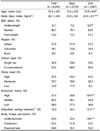1. Wang Y, Lobstein T. Worldwide trends in childhood overweight and obesity. Int J Pediatr Obes. 2006; 1:11–25.

2. Chisuwa N, O'Dea JA. Body image and eating disorders amongst Japanese adolescents. A review of the literature. Appetite. 2010; 54:5–15.

3. Lee S, Lee AM. Disordered eating in three communities of China: a comparative study of female high school students in hong kong, Shenzhen, and rural hunan. Int J Eat Disord. 2000; 27:317–327.

4. Perkins JM, Perkins HW, Craig DW. Peer weight norm misperception as a risk factor for being over and underweight among UK secondary school students. Eur J Clin Nutr. 2010; 64:965–971.

5. Abbott RA, Lee AJ, Stubbs CO, Davies PS. Accuracy of weight status perception in contemporary Australian children and adolescents. J Paediatr Child Health. 2010; 46:343–348.

6. Bergstrom R, Neighbors C. Body Image Disturbance and The Social Norms Approach: An Integrative Review of the Literature. J Soc Clin Psychol. 2006; 25:975–1000.

7. Martin MA, Frisco ML, May AL. Gender and race/ethnic differences in inaccurate weight perceptions among U.S. adolescents. Womens Health Issues. 2009; 19:292–299.

8. Nolan L, Grigorenko A, Thorstensson A. Balance control: sex and age differences in 9- to 16-year-olds. Dev Med Child Neurol. 2005; 47:449–454.

9. Rudolph H, Bluher S, Falkenberg C, Neef M, Korner A, Wurz J, Kiess W, Brahler E. Perception of body weight status: a case control study of obese and lean children and adolescents and their parents. Obes Facts. 2010; 3:83–91.

10. Wang Y, Liang H, Chen X. Measured body mass index, body weight perception, dissatisfaction and control practices in urban, low-income African American adolescents. BMC Public Health. 2009; 9:183.

11. Xie B, Chou CP, Spruijt-Metz D, Reynolds K, Clark F, Palmer PH, Gallaher P, Sun P, Guo Q, Johnson CA. Weight perception and weight-related sociocultural and behavioral factors in Chinese adolescents. Prev Med. 2006; 42:229–234.

12. Strauss RS. Self-reported weight status and dieting in a cross-sectional sample of young adolescents: National Health and Nutrition Examination Survey III. Arch Pediatr Adolesc Med. 1999; 153:741–747.

13. Cooke R, Sawyer SM. Eating disorders in adolescence. An approach to diagnosis and management. Aust Fam Physician. 2004; 33:27–31.
14. Wardle J, Haase AM, Steptoe A. Body image and weight control in young adults: international comparisons in university students from 22 countries. Int J Obes (Lond). 2006; 30:644–651.

15. Edwards NM, Pettingell S, Borowsky IW. Where perception meets reality: self-perception of weight in overweight adolescents. Pediatrics. 2010; 125:e452–e458.

16. Lee G, Ha Y, Vann JJ, Choi E. Weight perception and dieting behavior among Korean adolescents. J Sch Nurs. 2009; 25:427–435.

17. Kaneko K, Kiriike N, Ikenaga K, Miyawaki D, Yamagami S. Weight and shape concerns and dieting behaviours among pre-adolescents and adolescents in Japan. Psychiatry Clin Neurosci. 1999; 53:365–371.

18. Choi JH, Ahn DH, Nam JH, Jo YK, Choi BY. Reliability and validity of Eating Attitude Test-26 for Korean adolescents. Korean J Child Adol Psychiatry. 1998; 9:91–97.
19. Lee HJ, Park S, Kim CI, Choi DW, Lee JS, Oh SM, Cho E, Park HK, Kwon KI, Oh SW. The association between disturbed eating behavior and socioeconomic status: the Online Korean Adolescent Panel Survey (OnKAPS). PLoS One. 2013; 8:e57880.

20. Moon JS, Lee SY, Nam CM, Choi JM, Choe BK, Seo JW, Oh K, Jang MJ, Hwang SS, Yoo MH, Kim YT, Lee CG. 2007 Korean National Growth Charts: review of developmental process and an outlook. Korean J Pediatr. 2008; 51:1–25.

21. ter Bogt TF, van Dorsselaer SA, Monshouwer K, Verdurmen JE, Engels RC, Vollebergh WA. Body mass index and body weight perception as risk factors for internalizing and externalizing problem behavior among adolescents. J Adolesc Health. 2006; 39:27–34.

22. Suka M, Sugimori H, Yoshida K, Kanayama H, Sekine M, Yamagami T, Kagamimori S. Body image, body satisfaction and dieting behavior in Japanese preadolescents: The Toyama birth cohort study. Environ Health Prev Med. 2006; 11:24–30.

23. Talamayan KS, Springer AE, Kelder SH, Gorospe EC, Joye KA. Prevalence of overweight misperception and weight control behaviors among normal weight adolescents in the United States. ScientificWorldJournal. 2006; 6:365–373.

24. Neumark-Sztainer D, Paxton SJ, Hannan PJ, Haines J, Story M. Does body satisfaction matter? Five-year longitudinal associations between body satisfaction and health behaviors in adolescent females and males. J Adolesc Health. 2006; 39:244–251.

25. Kim DS, Cho Y, Cho SI, Lim IS. Body weight perception, unhealthy weight control behaviors, and suicidal ideation among Korean adolescents. J Sch Health. 2009; 79:585–592.

26. Wiseman CV, Sunday SR, Becker AE. Impact of the media on adolescent body image. Child Adolesc Psychiatr Clin N Am. 2005; 14:453–471. viii–ix.

27. Shi Z, Lien N, Nirmal Kumar B, Holmboe-Ottesen G. Perceptions of weight and associated factors of adolescents in Jiangsu Province, China. Public Health Nutr. 2007; 10:298–305.

28. Chen X, Wang Y. Is ideal body image related to obesity and lifestyle behaviours in African American adolescents? Child Care Health Dev. 2011.

29. Makino M, Hashizume M, Yasushi M, Tsuboi K, Dennerstein L. Factors associated with abnormal eating attitudes among female college students in Japan. Arch Womens Ment Health. 2006; 9:203–208.

30. KCDC. The Fourth Korea National Health and Nutrition Examination Survey (KNHANES IV), 2007-2009. Korean Centers for Disease Control and Prevention;2010.








 PDF
PDF ePub
ePub Citation
Citation Print
Print


 XML Download
XML Download